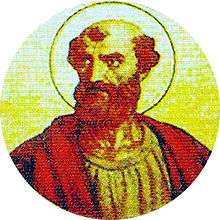Pope Alexander I
- Pope Alexander I can also refer to Pope Alexander I of Alexandria.
| Pope Saint Alexander I | |
|---|---|
 | |
| Papacy began | c. 107 |
| Papacy ended | c. 115 |
| Predecessor | Evaristus |
| Successor | Sixtus I |
| Personal details | |
| Birth name | Alexander |
| Born |
10 January 75 Rome, Roman Empire |
| Died |
c. 115 Rome, Roman Empire |
| Sainthood | |
| Feast day |
3 May (?)[1] (West) 16 March[2] (East) |
| Other popes named Alexander | |
Pope Alexander I (died c. 115) was the Bishop of Rome from c. 107 to his death c. 115. The Holy See's Annuario Pontificio (2012) identifies him as a Roman who reigned from 108 or 109 to 116 or 119. Some believe he suffered martyrdom under the Roman Emperor Trajan or Hadrian, but this is improbable.[3]
Life and legend
According to the Liber Pontificalis, it was Alexander I who inserted the narration of the Last Supper (the Qui pridie) into the liturgy of the Mass. However, the article on Saint Alexander I in the 1907 Catholic Encyclopedia, written by Thomas Shahan, judges this tradition to be inaccurate, a view shared by both Catholic and non-Catholic experts.[4] It is viewed as a product of the agenda of Liber Pontificalis—this section of the book was probably written in the late 5th century—to show an ancient pattern of the earliest bishops of Rome ruling the church by papal decree.
The introduction of the customs of using blessed water mixed with salt for the purification of Christian homes from evil influences, as well as that of mixing water with the sacramental wine, are attributed to Pope Alexander I. Some sources consider these attributions unlikely.[3] It is certainly possible, however, that Alexander played an important part in the early development of the Church of Rome's emerging liturgical and administrative traditions.
A later tradition holds that in the reign of Emperor Hadrian, Alexander I converted the Roman governor Hermes by miraculous means, together with his entire household of 1,500 people. Saint Quirinus of Neuss, who was Alexander's supposed jailer, and Quirinus' daughter Saint Balbina were also among his converts.
Alexander is said to have seen a vision of the infant Jesus.[5] His remains are said to have been transferred to Freising in Bavaria, Germany in AD 834.[4]
Supposed identification with a martyr
Some editions of the Roman Missal identified with Pope Alexander I the Saint Alexander that they give as commemorated, together with Saints Eventius and Theodulus (who were supposed to be priests of his), on 3 May. See, for instance, the General Roman Calendar of 1954. But nothing is known of these three saints other than their names, together with the fact that they were martyred and were buried at the seventh milestone of the Via Nomentana on 3 May of some year.[6] For this reason, the Pope John XXIII's 1960 revision of the calendar returned to the presentation that was in the 1570 Tridentine Calendar of the three saints as simply "Saints Alexander, Eventius and Theodulus Martyrs" with no suggestion that any of them was a pope. The Roman Martyrology lists them as Eventius, Alexander and Theodulus, the order in which their names are given in historical documents.[7]
See also
References
- ↑ In some editions of the Roman Missal printed after 1570 and before 1960
- ↑ (in Greek) Άγιος Αλέξανδρος ο Ιερομάρτυρας πάπας Ρώμης Ορθόδοξος Συναξαριστής
- 1 2 Encyclopædia Britannica: Saint Alexander I
- 1 2 Catholic Encyclopedia: Pope St. Alexander I
- ↑ Visions of Jesus: Direct Encounters from the New Testament to Today By Phillip H. Wiebe. Oxford University Press. p. 20.
- ↑ Calendarium Romanum (Libreria Editrice Vaticana 1969), p. 122
- ↑ Martyrologium Romanum (Libreria Editrice Vaticana 2004), p. 268
Further reading
- Benedict XIV. The Roman Martyrology. Gardners Books, 2007. ISBN 978-0-548-13374-3.
- Chapman, John. Studies on the Early Papacy. Port Washington, NY: Kennikat Press, 1971. ISBN 978-1-901157-60-4.
- Fortescue, Adrian, and Scott M. P. Reid. The Early Papacy: To the Synod of Chalcedon in 451. Southampton: Saint Austin Press, 1997. ISBN 978-1-901157-60-4.
- Jowett, George F. The Drama of the Lost Disciples. London: Covenant Pub. Co, 1968. OCLC 7181392
- Loomis, Louise Ropes. The Book of Popes (Liber Pontificalis). Merchantville, NJ: Evolution Publishing. ISBN 1-889758-86-8
- Pope St. Alexander I
| Titles of the Great Christian Church | ||
|---|---|---|
| Preceded by Evaristus |
Bishop of Rome Pope 106–115 |
Succeeded by Sixtus I |

